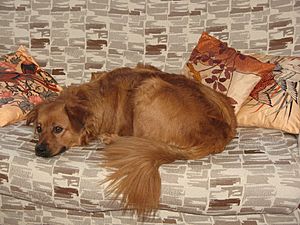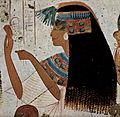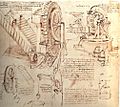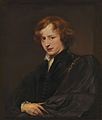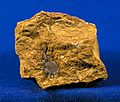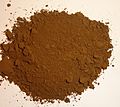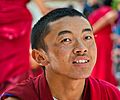Brown facts for kids
| This box shows the color brown. |
|---|
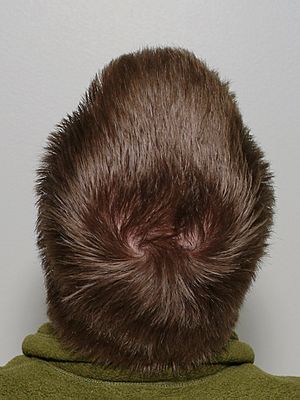
Brown is a very common color that you see all around you! It's the color of the earth, tree trunks, and many animals. Brown is made by mixing different colors together. For example, you can get brown by mixing orange and black, or by mixing red, blue, and yellow. It can also be made by mixing red and green, or orange and blue.
Brown is the color of many things we use and see every day:
- Some kinds of chocolate
- Wood from trees
- Toast
- Some people's hair
- Coffee
- The outer layer of a tree, called tree bark
Contents
What Makes Brown Special?
Brown is a very important color in nature. It helps animals like bears and deer blend in with their surroundings, which is called camouflage. Many soils are brown because of the minerals and decayed plants in them.
Brown in Art and History
Artists have used brown for thousands of years.
- In ancient caves like Lascaux, France, early humans used brown pigments to draw animals.
- Ancient Egyptians used brown to show skin color in their paintings.
- Famous artists like Rembrandt and Anthony van Dyck loved using brown in their paintings. They even had their own special brown colors!
- Leonardo da Vinci used a brownish ink called sepia, which came from cuttlefish.
Different Shades of Brown
Just like there are many shades of blue or green, there are many different shades of brown! Some browns are very light, like the color of sand or a light coffee. Others are very dark, almost black, like dark chocolate or rich soil.
Here are some examples of brown shades and what they are named after:
- Tan is a light brown, like the color of skin after a lot of sun.
- Beige is a very light, yellowish-brown, often seen in natural wool.
- Sienna and Umber are natural brown pigments that come from special clays found in the earth. Sienna is often reddish-brown, while umber can be darker.
- Khaki is a dull, yellowish-brown color. It comes from a Persian word meaning "earth" and is often used for military uniforms because it helps soldiers blend in.
- Chocolate is a rich, dark brown, named after the delicious treat!
- Auburn and Chestnut are reddish-brown colors often used to describe hair.
Brown in Everyday Life
Brown is a popular color for many things because it's natural, warm, and often practical.
- Many clothes are brown, especially coats and shoes.
- Furniture, like wooden tables and chairs, is often brown.
- Even some vehicles, like UPS delivery trucks, are painted a specific shade of brown!
Brown is a color that connects us to nature and history. It's everywhere you look!
Related pages
Images for kids
-
Painting of a dun horse on the wall of Lascaux Cave in France.
-
A tan terracotta background on a Greek amphora with the figures of Hercules and Apollo. (about 720 BC).
-
Self-portrait of Rembrandt. The older Rembrandt became the more brown he used in his paintings.
-
Anthony van Dyck, like Rembrandt, was attached to the pigment called Cassel earth or Cologne earth; it became known as Van Dyck brown.
-
Iron oxide is the most common ingredient in brown pigments.
-
Limonite is a form of yellowish iron ore. A clay of limonite rich in iron oxide is the source of raw sienna and burnt sienna.
-
Natural or raw umber pigment is clay rich in iron oxide and manganese.
-
A dark brown iris is most common in East Asia, Southeast Asia, and South Asia.
-
A light brown iris is most common in North Africa, Eastern Europe, the Americas and West Asia.
-
Nadeeka Perera, a fashion model from Sri Lanka.
-
Auburn hair is a reddish brown. This is actress Susan Sarandon.
-
A typical soil profile; dark-brown topsoils, rich with organic matter, above reddish-brown lower layers.
-
A profile of layers of Mollisols, the soil type found in the Great Plains of the U.S., the Pampas in Argentina, and the Russian Steppes.
-
The brown bear is found across Eurasia and North America.
-
The fur of the snowshoe hare is brown in the summer and turns white in winter, as a form of all-season natural camouflage.
-
Camel is an effective color for camouflage in the Sahara desert, and is also a popular color for blankets and winter overcoats.
-
General Douglas MacArthur in Khaki on August 2, 1945.
-
The Sahara Desert around the Kufra Oasis, Libya, seen from space.
-
Chocolate. A sachertorte in a Vienna cafe.
-
Espresso-roasted coffee beans.
-
People dressed as 1st World War soldiers as part of the commemoration of the battle of the Somme. The word khaki means "earth" in the Persian language.
-
A dun-colored horse. Donn is the word for brown in the Scottish and Irish Gaelic languages.
-
Pieces of natural amber.
-
Bodybuilders who have been spray tanned.
-
Pieces of caramel.
-
A monk of the Franciscan order. Plain brown wool symbolizes humility.
-
An ochre quarry in France.
-
Layers of soil in Ireland. Dark brown soil usually contains a high amount of decayed organic matter.
-
Different sorts of chestnuts.
-
Russet potatoes. They take their name from the color of russet, a coarse brown homespun cloth.
-
Beige is a very light brown color, taking its name from the French word for the color of natural wool.
-
Puce is defined in the United States and UK as a brownish-purple or purple-brown color. In France, where it was invented, it is described as a dark reddish brown.
-
The color drab is a dull light brown, which takes its name from drap, the old French word for undyed wool cloth. It is best known for the olive-green shade called olive drab, formerly worn by U.S. soldiers. Drab has come to mean dull, lifeless and monotonous.
See also
 In Spanish: Marrón para niños
In Spanish: Marrón para niños


